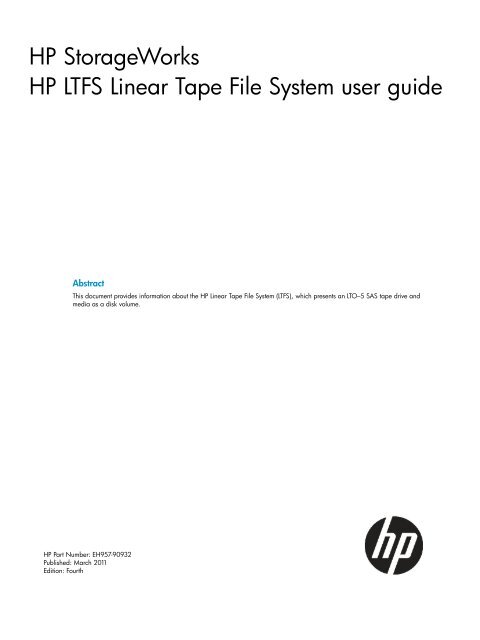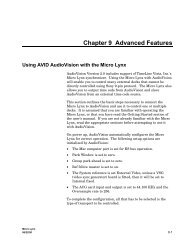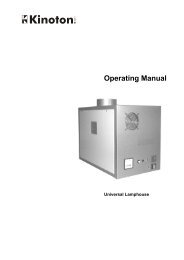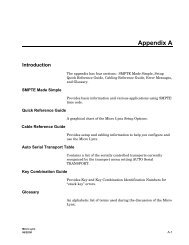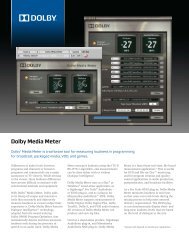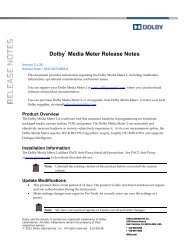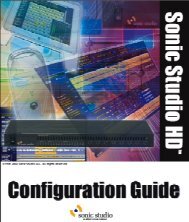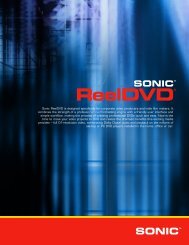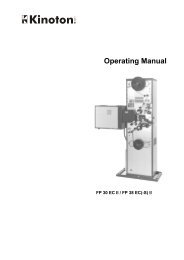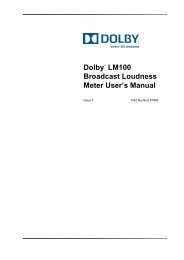HP LTFS Linear Tape File System user guide
HP LTFS Linear Tape File System user guide
HP LTFS Linear Tape File System user guide
You also want an ePaper? Increase the reach of your titles
YUMPU automatically turns print PDFs into web optimized ePapers that Google loves.
<strong>HP</strong> StorageWorks<br />
<strong>HP</strong> <strong>LTFS</strong> <strong>Linear</strong> <strong>Tape</strong> <strong>File</strong> <strong>System</strong> <strong>user</strong> <strong>guide</strong><br />
Abstract<br />
This document provides information about the <strong>HP</strong> <strong>Linear</strong> <strong>Tape</strong> <strong>File</strong> <strong>System</strong> (<strong>LTFS</strong>), which presents an LTO–5 SAS tape drive and<br />
media as a disk volume.<br />
<strong>HP</strong> Part Number: EH957-90932<br />
Published: March 2011<br />
Edition: Fourth
© Copyright 2010 Hewlett-Packard Development Company, L.P.<br />
Confidential computer software. Valid license from <strong>HP</strong> required for possession, use or copying. Consistent with FAR 12.211 and 12.212, Commercial<br />
Computer Software, Computer Software Documentation, and Technical Data for Commercial Items are licensed to the U.S. Government under<br />
vendor's standard commercial license.<br />
The information contained herein is subject to change without notice. The only warranties for <strong>HP</strong> products and services are set forth in the express<br />
warranty statements accompanying such products and services. Nothing herein should be construed as constituting an additional warranty. <strong>HP</strong> shall<br />
not be liable for technical or editorial errors or omissions contained herein.<br />
Acknowledgements<br />
Apple® and Mac OS® X are trademarks of Apple Inc., registered in the U.S. and other countries.<br />
Linux® is the registered trademark of Linus Torvalds in the U.S. and other countries.<br />
<strong>Linear</strong> <strong>Tape</strong>-Open, LTO, LTO Logo, Ultrium and Ultrium Logo are trademarks of Quantum, <strong>HP</strong> and IBM in the US, other countries or both.
Contents<br />
1 Introduction...............................................................................................4<br />
Features..................................................................................................................................4<br />
Benefits...................................................................................................................................4<br />
Intended usage........................................................................................................................4<br />
Architecture.............................................................................................................................5<br />
Supported configurations...........................................................................................................5<br />
2 Linux: Installation and configuration..............................................................6<br />
Downloading and installing <strong>HP</strong> <strong>LTFS</strong> (precompiled binaries)) .........................................................6<br />
To uninstall <strong>LTFS</strong>........................................................................................................................7<br />
3 Mac OS X: Installation and configuration......................................................8<br />
Downloading and installing <strong>HP</strong> <strong>LTFS</strong> (precompiled binaries)) .........................................................8<br />
To uninstall <strong>LTFS</strong>...................................................................................................................8<br />
4 Using <strong>HP</strong> <strong>LTFS</strong>............................................................................................9<br />
How to use <strong>LTFS</strong>.......................................................................................................................9<br />
Usage details.........................................................................................................................10<br />
Format version compatibility................................................................................................10<br />
Use of sync_type options.....................................................................................................11<br />
User permissions................................................................................................................12<br />
<strong>File</strong> permissions.................................................................................................................12<br />
<strong>File</strong> types..........................................................................................................................12<br />
<strong>File</strong> names........................................................................................................................12<br />
Limitations.............................................................................................................................12<br />
5 <strong>HP</strong> <strong>Tape</strong>Assure drive monitoring.................................................................14<br />
6 Troubleshooting........................................................................................15<br />
General................................................................................................................................15<br />
Shared libraries......................................................................................................................15<br />
Drive connection.....................................................................................................................15<br />
Using <strong>HP</strong> <strong>LTFS</strong> to check the cartridge.........................................................................................16<br />
7 Frequently asked questions.........................................................................17<br />
8 Support and other resources......................................................................18<br />
Contacting <strong>HP</strong>........................................................................................................................18<br />
Subscription service............................................................................................................18<br />
Related information.................................................................................................................18<br />
Documentation..................................................................................................................18<br />
<strong>HP</strong> websites......................................................................................................................18<br />
Typographic conventions.........................................................................................................18<br />
<strong>HP</strong> product documentation survey.............................................................................................19<br />
Contents 3
1 Introduction<br />
Features<br />
Benefits<br />
This <strong>guide</strong> provides information about <strong>HP</strong> <strong>Linear</strong> <strong>Tape</strong> <strong>File</strong> <strong>System</strong> (<strong>HP</strong> <strong>LTFS</strong>) Software. <strong>HP</strong> <strong>LTFS</strong><br />
makes tape self-describing, file-based, and easy-to-use and provides <strong>user</strong>s with the ability to use<br />
standard file operations on tape media for accessing, managing and sharing files with an interface<br />
that behaves as a hard disk. In addition, <strong>HP</strong> <strong>LTFS</strong> provides the ability to share data across platforms,<br />
as you would with a USB drive or memory stick.<br />
NOTE: A firmware update may be required. <strong>HP</strong> <strong>LTFS</strong> will check and tell you if your tape drive<br />
needs updating.<br />
• Provides all you need to use LTO–5 tape media as a disk<br />
• Based on Open Source software<br />
• Precompiled application versions provided for supported platforms<br />
• Full source code available<br />
• Supported on Linux® and and Mac OS® X<br />
In addition to the wide range of benefits that <strong>HP</strong> LTO-5 <strong>Tape</strong> drives have to offer, <strong>HP</strong> LTO-5 with<br />
<strong>Linear</strong> <strong>Tape</strong> <strong>File</strong> <strong>System</strong> (<strong>LTFS</strong>) functionality also delivers:<br />
• Faster access to data: When a tape is mounted, the files and directories stored on it appear<br />
on desktop in the same way as a disk directory listing.<br />
• Simple drag and drop: <strong>HP</strong> <strong>LTFS</strong> increases ease of use, simply drag and drop files to and from<br />
the tape.<br />
• Compatibility across your environment: <strong>Tape</strong> media written using <strong>HP</strong> <strong>LTFS</strong> is self-describing<br />
so that data retrieval from tape is independent of any hardware or software platforms.<br />
• Increased data mobility: Easily share content to increase data mobility; tapes written with the<br />
<strong>HP</strong> <strong>LTFS</strong> application can be exchanged more easily between <strong>user</strong>s working in different<br />
operating systems, using different software and in different locations.<br />
• A single storage media standard. Unify organization-wide file sharing with <strong>HP</strong> LTO-5. <strong>Tape</strong>s<br />
can move across libraries and vendors with the ease of video cassettes, while files on tape<br />
can be accessed using straightforward drag-and-drop.<br />
Intended usage<br />
The <strong>HP</strong> <strong>LTFS</strong> application presents the contents of the tape as a disk volume. However it is important<br />
to bear in mind that it is not a true disk, and therefore there are some best practices to follow to<br />
ensure satisfactory performance and a good <strong>user</strong> experience.<br />
1. <strong>HP</strong> <strong>LTFS</strong> is designed to work best in a single-<strong>user</strong> environment, where just one <strong>user</strong> is copying<br />
files to or from the tape. Multiple <strong>user</strong>s or processes trying to write and/or read at the same<br />
time will result in poor performance due to the sequential access nature of tape.<br />
2. For the same reasons, the tape drive should not be shared between different systems. A single<br />
tape drive should be connected to a single host bus adapter (HBA).<br />
3. The expected usage model is to transfer large files between systems, by mounting the tape on<br />
one system, writing the files, unmounting, mounting on the second system, and reading the<br />
4 Introduction
Architecture<br />
files. Treating the tape volume as a true random access device (for example frequently reading<br />
and updating individual files) will not perform as well as streaming large files to/from tape.<br />
4. The <strong>HP</strong> <strong>LTFS</strong> application will work in conjunction with graphical file explorer programs such<br />
as Nautilus or Konqueror (on Linux). However because these types of applications tend to try<br />
to pre-read files in the directory, using the graphical explorer window may lead to poor<br />
performance. Optimum performance will be enjoyed by using a terminal window and issuing<br />
shell commands to copy data, view directory contents etc.<br />
<strong>HP</strong> <strong>LTFS</strong> is a <strong>user</strong> space application, making use of the FUSE kernel mode subsystem included in<br />
Linux systems. On the Apple® Mac OS platform it uses the MacFUSE module.<br />
Supported configurations<br />
<strong>HP</strong> <strong>LTFS</strong> supports:<br />
• LTO–5 Ultrium 3000 and 3280 <strong>Tape</strong> Drives with SAS interfaces<br />
• Red Hat Enterprise Linux (RHEL) 5.4 and later (32-bit and 64-bit)<br />
• SuSE Enterprise Linux (SLES) 11 (32-bit and 64-bit)<br />
• Mac OS X Leopard (10.5.8) and Snow Leopard (10.6, 32-bit kernel only)<br />
NOTE: Only the binaries supplied by <strong>HP</strong> are supported, not those built from the source. See the<br />
Compatibility Matrix on http://www.hp.com/go/ltfs for the latest details on supported operating<br />
system configurations and supported HBA and hardware configurations.<br />
Architecture 5
2 Linux: Installation and configuration<br />
When using <strong>HP</strong> <strong>LTFS</strong> with <strong>HP</strong> LTO-5 tape drives, the following components are required:<br />
• A drive firmware revision that supports dual partitioning. <strong>HP</strong> <strong>LTFS</strong> will check and tell you if<br />
your tape drive needs updating. <strong>HP</strong> L&TT should be used if a firmware update is required.<br />
• The software package that contains the “run-time” executable, this can be found at http://<br />
www.hp.com/go/<strong>LTFS</strong><br />
• The FUSE kernel module<br />
NOTE:<br />
<strong>HP</strong> L&TT can be downloaded from http://www.hp.com/support/tapetools.<br />
Downloading and installing <strong>HP</strong> <strong>LTFS</strong> (precompiled binaries))<br />
1. Before starting to install and use <strong>HP</strong> <strong>LTFS</strong>, you must ensure that the FUSE kernel module is<br />
present and loaded.<br />
To check, execute the following command:<br />
$ lsmod | grep fuse<br />
• If the module is not listed as currently loaded, you must load it before proceeding:<br />
$ modprobe fuse<br />
• If the module is not present on your system, you must first obtain and install it. Details of<br />
how to do this are beyond the scope of this document; refer to http://fuse.sourceforge.net/<br />
for further information.<br />
2. Determine whether you want to use precompiled binaries or build your own version of the <strong>HP</strong><br />
<strong>LTFS</strong> application.<br />
To build your own, download and unpack the file <strong>HP</strong><strong>LTFS</strong>_SOURCE.tar.gz then follow the<br />
instructions in ltfs-1.2.0/doc/BUILDING.linux.<br />
IMPORTANT:<br />
Currently, <strong>HP</strong> only supports installations using the precompiled binaries.<br />
3. To use precompiled binaries, download the appropriate Binaries file and unpack it:<br />
• Red Hat Enterprise Linux: Download <strong>HP</strong><strong>LTFS</strong>_BINARIES_RHEL5.tar.gz<br />
• SuSE Enterprise Linux (SLES): Download <strong>HP</strong><strong>LTFS</strong>_BINARIES_SLES11.tar.gz<br />
For example on a Linux RHEL5.4 or later system:<br />
$ gunzip <strong>HP</strong><strong>LTFS</strong>_BINARIES_RHEL5.tar.gz<br />
$ tar xvf <strong>HP</strong><strong>LTFS</strong>_BINARIES_RHEL5.tar and select the appropriate file for your<br />
installation:<br />
<strong>HP</strong><strong>LTFS</strong>_BINARIES_RHEL5.tar.gz contains the following files:<br />
• <strong>HP</strong><strong>LTFS</strong>_BINARIES_RHEL5.4_x86.tar.gz (for x86 32-bit installations)<br />
• <strong>HP</strong><strong>LTFS</strong>_BINARIES_RHEL5.4_x64.tar.gz (for x64 64-bit installations)<br />
NOTE: Although the file name for the first two files includes RHEL5.4, the executables<br />
have been tested by <strong>HP</strong> and verified for correct operation on versions up to and including<br />
RHEL 6.0.<br />
• README.txt (general usage info)<br />
• INSTALLING.txt (prerequisites and how-to install)<br />
• COPYING.lib (LGPL v2.1 required licensing text)<br />
6 Linux: Installation and configuration
<strong>HP</strong><strong>LTFS</strong>_BINARIES_SLES11.tar.gz contains a similar set of files with appropriate SLES11<br />
binaries for 32–bit and 64–bit installations.<br />
4. Unpack the appropriate package for your architecture into the root directory.<br />
For example, on a RHEL5.4 32–bit installation:<br />
$ gunzip <strong>HP</strong><strong>LTFS</strong>_BINARIES_RHEL5.4_x86.tar.gz<br />
$ tar xvf <strong>HP</strong><strong>LTFS</strong>_BINARIES_RHEL5.4_x86.tar -C /<br />
Or on a SLES11 64–bit installation:<br />
$ gunzip <strong>HP</strong><strong>LTFS</strong>_BINARIES_SLES11_x64.tar.gz<br />
$ tar xvf <strong>HP</strong><strong>LTFS</strong>_BINARIES_SLES11_x64.tar -C /<br />
5. This will place three executables in /usr/local/bin/ (ltfs, mkltfs, ltfsck).<br />
It will also place a number of dynamic libraries in /usr/local/lib/ and in a new<br />
subdirectory called /usr/local/lib/ltfs/ .<br />
6. <strong>HP</strong> <strong>LTFS</strong> is now installed. See Using <strong>HP</strong> <strong>LTFS</strong> for next steps.<br />
NOTE: The precompiled binaries supplied by <strong>HP</strong> require additional shared libraries which may<br />
not be present on every system, or which may need to be updated in order for the binaries to<br />
execute. Refer to the <strong>LTFS</strong> release notes for more details.<br />
To uninstall <strong>LTFS</strong><br />
If at a later date you want to uninstall <strong>LTFS</strong> from your system, delete the following files and<br />
directories:<br />
• /usr/local/bin/*ltfs*<br />
• /usr/local/etc/ltfs*<br />
• /usr/local/share/ltfs*<br />
• /usr/local/lib/libltfs*<br />
• /usr/local/lib/ltfs/*<br />
To uninstall <strong>LTFS</strong> 7
3 Mac OS X: Installation and configuration<br />
When using <strong>HP</strong> <strong>LTFS</strong> with <strong>HP</strong> LTO-5 tape drives, the following components are required:<br />
• A drive firmware revision that supports dual partitioning<br />
• The software package that contains the “run-time” executable<br />
• The MacFUSE kernel module<br />
NOTE: <strong>HP</strong> <strong>LTFS</strong> will check and tell you if your tape drive needs updating. <strong>HP</strong> L&TT should be<br />
used if a firmware update is required. It can be downloaded from http://www.hp.com/support/<br />
tapetools.<br />
Downloading and installing <strong>HP</strong> <strong>LTFS</strong> (precompiled binaries))<br />
1. Before starting to install and use <strong>LTFS</strong>, you must ensure that the MacFUSE module version<br />
2.0.3,2 is present and loaded.<br />
If the module is not present on your system, you must first obtain and install it. Details of how<br />
to do this are beyond the scope of this document; refer to http://code.google.com/p/macfuse/<br />
for further information.<br />
2. Determine whether you want to use precompiled binaries or build your own version of the <strong>HP</strong><br />
<strong>LTFS</strong> application.<br />
To build your own, download and unpack the file <strong>HP</strong><strong>LTFS</strong>_SOURCE.tar.gz then follow the<br />
instructions in ltfs-1.2.0/doc/BUILDING.macosx.<br />
IMPORTANT:<br />
Currently, <strong>HP</strong> only supports installations using the precompiled binaries.<br />
3. To use precompiled binaries, download the file <strong>HP</strong><strong>LTFS</strong>_BINARIES.dmg.<br />
4. This contains packages for both Leopard (10.5.8) and Snow Leopard (10.6, 32-bit kernel)<br />
configurations. Open the image by double-clicking on it in a Finder window and navigate to<br />
your OS version.<br />
5. Install the ICU package first by double-clicking on the file ICUFramework-4.0.1.pkg and<br />
following the instructions.<br />
6. Now install the <strong>LTFS</strong> package by double-clicking on the file <strong>Linear</strong><strong>Tape</strong><strong>File</strong><strong>System</strong>.pkg<br />
and following the instructions.<br />
7. <strong>HP</strong> <strong>LTFS</strong> is now installed. See Using <strong>HP</strong> <strong>LTFS</strong> for next steps.<br />
To uninstall <strong>LTFS</strong><br />
If at a later date you want to uninstall <strong>LTFS</strong> from your system, delete /usr/local/bin/*ltfs*<br />
and then delete the tree under /Library/Frameworks/<strong>LTFS</strong>.framework.<br />
To also delete the ICU package, delete the tree under/Library/Frameworks/ICU.framework.<br />
8 Mac OS X: Installation and configuration
4 Using <strong>HP</strong> <strong>LTFS</strong><br />
How to use <strong>LTFS</strong><br />
1. Open a terminal window on your system. Ensure that /usr/local/bin/ is in your command<br />
search path. For example:<br />
$ export PATH="$PATH:/usr/local/bin"<br />
2. Load a tape cartridge into the drive, and then format it in <strong>LTFS</strong> format:<br />
For Linux:<br />
$ mkltfs -d /dev/st0<br />
For Mac OS X<br />
$ mkltfs -d 0<br />
mkltfs options:<br />
–d, -–device=<br />
–s, -–tape-serial=<br />
–n, -–volume-name=<br />
–r, -–rules=<br />
–o, -–no-override<br />
–q, -–quiet<br />
–f, -–force<br />
–t, -–trace<br />
–h, -–help<br />
–p, -–advanced-help<br />
<strong>Tape</strong> device (required).<br />
For Linux use the device name such as /dev/st0.<br />
For MacOS X, use the instance number of the tape drive, assigned<br />
sequentially by the system starting from 0.<br />
<strong>Tape</strong> serial number (6 alphanumeric ASCII characters)<br />
<strong>Tape</strong> volume name (empty by default)<br />
Rules for choosing files to write to the index partition. The syntax of<br />
the rules argument is:<br />
• size=1M<br />
• size=1M/name=pattern<br />
• size=1M/name=pattern1:pattern2:pattern3<br />
A file is written to the index partition if it is no larger than the given<br />
size AND matches at least one of the name patterns (if specified).<br />
The size argument accepts K, M and G suffixes. Name patterns<br />
may contain the special characters '' (match any single character)<br />
and '*' (match zero or more characters).<br />
Disallow mount-time data placement policy changes<br />
Suppress progress information and general messages<br />
Force reformat of existing <strong>LTFS</strong> volume (normally disallowed)<br />
Enable function call tracing (only useful for debugging)<br />
This help<br />
Full help, including advanced options<br />
3. Mount the formatted tape cartridge<br />
$ mkdir /mnt/lto5<br />
$ ltfs /mnt/lto5<br />
ltfs options:<br />
–o devname=<br />
–o work_directory=<br />
–o trace<br />
–o eject<br />
<strong>Tape</strong> device (default: /dev/st0)<br />
<strong>LTFS</strong> work directory (default: /tmp/ltfs/)<br />
Enable diagnostic output<br />
Eject the cartridge after unmount<br />
How to use <strong>LTFS</strong> 9
–o sync_type=<br />
-o force_mount_no_eod<br />
–a<br />
–V, -–version<br />
–h, -–help<br />
FUSE options:<br />
-o umask=M<br />
-o uid=N<br />
-o gid=N<br />
Specify sync type (default: time@5). should be specified<br />
as follows:<br />
• time@min: <strong>LTFS</strong> attempts to write an index each min minutes;<br />
min should be a decimal number from 1 to 65536 (default:<br />
min=5)<br />
• close: <strong>LTFS</strong> attempts to write an index when a file is closed<br />
• unmount: <strong>LTFS</strong> attempts to write an index when the medium is<br />
ummounted<br />
Skip EOD existence check when mounting (read-only mount) Only<br />
use for a CM corrupted medium<br />
Advanced help, including standard FUSE options<br />
Output version information and exit<br />
Display this help and exit<br />
Set file permissions (octal)<br />
Set file owner<br />
Set file group<br />
NOTE: On Mac OS X, the <strong>LTFS</strong> application always runs as a foreground process and the<br />
terminal window will now be dedicated to the running <strong>LTFS</strong> process. Open another terminal<br />
tab or window to continue.<br />
4. Write files to the <strong>LTFS</strong> volume. For example:<br />
$ cp -r /root /mnt/lto5/<br />
5. Unmount the tape cartridge. This flushes the data buffer of the file system to the tape cartridge,<br />
and prepares for eject.<br />
$ umount /mnt/lto5<br />
or<br />
$ f<strong>user</strong>mount -u /mnt/lto5<br />
NOTE:<br />
f<strong>user</strong>mount is only available on Linux.<br />
Usage details<br />
IMPORTANT: The umount (or f<strong>user</strong>mount) command will return immediately, but the<br />
drive may still be busy writing cached data to tape. Do not attempt to remove the tape cartridge<br />
from the drive until all activity has finished. Check the front panel LEDs and wait for them to<br />
stop flashing. Attempting to remove the cartridge before this may cause corruption of the tape<br />
format.<br />
Format version compatibility<br />
Earlier versions of the <strong>HP</strong> <strong>LTFS</strong> application supported the original 1.0 <strong>LTFS</strong> format specification;<br />
this version (v1.2.0) supports the updated 2.0.0 <strong>LTFS</strong> format specification. <strong>LTFS</strong> volumes created<br />
with application v1.2.0 will not be readable in older versions of the <strong>LTFS</strong> application, as shown<br />
in the following table:<br />
10 Using <strong>HP</strong> <strong>LTFS</strong>
Table 1 <strong>LTFS</strong> compatibility<br />
<strong>LTFS</strong> application<br />
v1.1.0 or earlier<br />
v1.2.0 or later<br />
Cartridge written by <strong>LTFS</strong> application<br />
v1.1.0 or earlier<br />
Read/Write ok<br />
Readable ok; will automatically be<br />
converted to new format if written<br />
Cartridge written by v1.2.0 or later<br />
Cannot be mounted<br />
Read/Write ok<br />
<strong>HP</strong> recommends that all instances of <strong>HP</strong> <strong>LTFS</strong> should be updated to v1.2.0 to avoid these<br />
compatibility issues.<br />
If, for some reason, it is important to maintain cartridges readable by previous versions of the <strong>HP</strong><br />
<strong>LTFS</strong> application, care should be taken to avoid writing to those cartridges with the new version<br />
of the application. This may be accomplished by mounting the volume as read-only, or by using<br />
the cartridge write-protect tab to prevent cartridge updates. However, this should be regarded as<br />
a temporary measure until all the application instances can be updated to v1.2.0.<br />
Use of sync_type options<br />
Previous versions of <strong>HP</strong> <strong>LTFS</strong> supported a single mechanism for updating the tape index, wherein<br />
the index was written to tape only when the volume was unmounted. In normal operation this is<br />
sufficient since the <strong>LTFS</strong> usage model requires the volume to be unmounted after use, so there is<br />
always a valid index. However, if power is removed from the drive without unmounting, for example<br />
due to an unplanned power outage or accidental unplugging, the volume will be left in an<br />
inconsistent state and all files added since the last dismount operation will be inaccessible. The<br />
ltfsck utility may be able to recover the file data to the _ltfs_lostandfound directory but<br />
the metadata (filename, access dates etc) will be lost.<br />
To address this exposure, <strong>HP</strong> <strong>LTFS</strong> v1.2.0 offers two additional mechanisms for updating the tape<br />
index. The first is to write a copy of the index to tape on a periodic basis whilst writing data; this<br />
is the new default behavior and the index is written out every five minutes. The time interval can<br />
be set with a resolution of one minute. This method of index update reduces the window of exposure<br />
to power loss events, since there will be an index on tape no more than five minutes old (if using<br />
the default interval).<br />
The second new mechanism provided in <strong>HP</strong> <strong>LTFS</strong> v1.2.0 is to update the index every time a file is<br />
closed after writing. This further reduces the exposure window to a single file, or (if several processes<br />
are using the volume simultaneously) to the number of files being written concurrently. However,<br />
this does add some overhead to <strong>LTFS</strong>, both in terms of the tape capacity used for each index, and<br />
also in terms of performance since the writing of the index will take bandwidth away from writing<br />
data. These overhead effects will become more severe with smaller file sizes.<br />
In most cases the default <strong>HP</strong> <strong>LTFS</strong> behavior offers the best solution, but the new features allow the<br />
behavior to be tailored to a particular situation. The following table summarizes the options now<br />
available for choosing when the index is updated.<br />
Usage details 11
Table 2 Index update options<br />
sync_type<br />
Index is flushed to tape<br />
Potential benefits<br />
Potential downsides<br />
unmount<br />
when volume is unmounted<br />
(default <strong>LTFS</strong> v1.1.0<br />
behavior)<br />
• Minimal capacity<br />
overhead<br />
• No impact on<br />
performance<br />
• Exposure to risk of power<br />
fails during writing<br />
time@n<br />
every n minutes during<br />
writing (default <strong>LTFS</strong> v1.2.0<br />
behavior, n=5)<br />
• Exposure to risk of power<br />
fails limited to last n<br />
minutes<br />
• Some capacity overhead<br />
since writing index more<br />
frequently<br />
• Negligible impact on<br />
performance<br />
close<br />
when any file opened for<br />
writing is closed<br />
• Exposure to risk of power<br />
fails limited to single file<br />
(more if several processes<br />
writing to different files<br />
concurrently)<br />
• Greater capacity and<br />
performance overhead,<br />
especially if writing small<br />
files<br />
User permissions<br />
Note that on some systems, the logged-in <strong>user</strong> may not have access rights to the tape device (e.g.<br />
/dev/st0). This may be addressed by (a) having a super <strong>user</strong> change permissions on the tape<br />
device file; or (b) executing the ltfs command with the sudo command (e.g. sudo ltfs<br />
/mnt/lto5). <strong>HP</strong> recommends the second approach since this preserves the integrity of the system.<br />
<strong>File</strong> permissions<br />
<strong>File</strong> types<br />
<strong>File</strong> names<br />
Limitations<br />
12 Using <strong>HP</strong> <strong>LTFS</strong><br />
The <strong>HP</strong> <strong>LTFS</strong> application manages a common set of file permissions for all files and <strong>user</strong>s; file and<br />
directory ownership is not recorded to tape media. The only permission that is tracked is write-protect<br />
information. <strong>File</strong>s or directories that are write-protected will have permission bits set to 555;<br />
write-enabled files and directories have permission set to 777. By default the <strong>user</strong> and group<br />
information is set to that of the current <strong>user</strong>; this can be overridden by use of the -o uid and -o<br />
gid options to the <strong>LTFS</strong> application.<br />
The <strong>HP</strong> <strong>LTFS</strong> application does not support the creation of symbolic links or hard links within the<br />
tape file system. Attempting to create a link or copy a link to tape will result in a "Function not<br />
implemented" error. If using the cp command to copy to tape, the '-L' option may be helpful<br />
to follow symlinks.<br />
The <strong>HP</strong> <strong>LTFS</strong> application also does not support creation of special files and will report "Function<br />
not implemented".<br />
To maintain compatibility when copying files between multiple platforms, it is strongly recommended<br />
that the following characters should not be used in <strong>HP</strong> <strong>LTFS</strong> for file names, directory names, or<br />
extended attributes: * < > : " | / \<br />
• When the tape cartridge is almost full, further write operations will be prevented. The free<br />
space on the tape (e.g. from the df command) will indicate that there is still some capacity<br />
available, but that is reserved for updating the index when the tape is unmounted.<br />
• Future mounts of a cartridge that is almost full (has passed the point at which "early warning"<br />
is reported) will mount as Read Only, to prevent further modifications which may not fit on
tape. This status is cleared when a cartridge is reformatted (using mkltfs) or when the volume<br />
is rolled back erasing history (using ltfsck).<br />
MAC OS X only<br />
• The ltfs program will currently always run in the foreground (equivalent to passing -f option).<br />
This is done automatically and may be changed in future releases.<br />
• <strong>LTFS</strong> does not support moving a folder within <strong>LTFS</strong>. Any attempt to move a folder in such a<br />
manner will result in an "operation not permitted" error, and the operation will be ignored.<br />
The <strong>user</strong> can still move a file within <strong>LTFS</strong>, and the <strong>user</strong> can also move a folder from <strong>LTFS</strong> to<br />
non-<strong>LTFS</strong> file system or vice versa.<br />
• Mac OS X's Spotlight will not display the files on <strong>LTFS</strong> as a result of search.<br />
Limitations 13
5 <strong>HP</strong> <strong>Tape</strong>Assure drive monitoring<br />
A drive monitoring service for <strong>HP</strong> <strong>LTFS</strong> on Linux is available as a separate download offering<br />
access to:<br />
• Drive Health — write/read quality levels, key drive life indicators, and any service actions<br />
• Drive Performance — host and media transfer rates and compression ratios<br />
• Drive Utilization – the time the drive is in use as a percentage<br />
• <strong>Tape</strong> Health – effective capacity, key tape life indicators and any service actions<br />
• <strong>Tape</strong> Utilization – write and read data volumes and capacity used<br />
The download has two parts:<br />
• The <strong>Tape</strong>Assure service that runs on the <strong>LTFS</strong> server<br />
• CommandView TL which is used to store and view the <strong>Tape</strong>Assure data<br />
Note that CommandView TL is a web-based management application for <strong>HP</strong>’s enterprise tape<br />
libraries that runs on Windows systems and needs to have network connectivity with the <strong>Tape</strong>Assure<br />
service. It is used with the <strong>HP</strong> <strong>LTFS</strong> <strong>Tape</strong>Assure service in this configuration for access to the<br />
<strong>Tape</strong>Assure data only and references to library functionality should be ignored.<br />
See http://www.hp.com/go/tapeassure for further details, downloads and <strong>user</strong> <strong>guide</strong>s.<br />
14 <strong>HP</strong> <strong>Tape</strong>Assure drive monitoring
6 Troubleshooting<br />
General<br />
If problems occur during <strong>HP</strong> <strong>LTFS</strong> operation, entries may be made in the system log (e.g.<br />
/var/log/messages on RHEL systems). Check for entries made with the service name “ltfs”.<br />
Both ltfs and mkltfs have command line options to report further details of the operations<br />
undertaken, which may be of assistance when trying to troubleshoot problems.<br />
If there is a problem with drive interaction, <strong>HP</strong> <strong>LTFS</strong> will attempt to create a snapshot of the drive<br />
internal state at the time of failure. A snapshot may also be taken at unmount time.<br />
• On Linux systems: this will be stored in the system log directory (e.g. /var/log/) and will<br />
take the form ltfs_datestamp_timestamp_driveSerialNum.ltd.<br />
• On Mac OS X systems: the snapshots are stored in the directory ~/Library/Logs/<strong>LTFS</strong>/.<br />
These files are not otherwise used by <strong>HP</strong> <strong>LTFS</strong> and they may safely be removed from the system,<br />
if they are not needed for troubleshooting.<br />
Note that logs may not be created, and warning messages issued, in either of the following cases:<br />
• (a) the ltfs process does not have write permissions for the log directory<br />
Resolution: Run ltfs as root, or use the log_directory option to specify a directory for<br />
which it does have the required permissions.<br />
• (b) the log directory does not exist<br />
Shared libraries<br />
Resolution: Create the log directory indicated, or use the log_directory option to specify<br />
a directory which already exists.<br />
On some systems, trying to execute the ltfs command may result in an error message of the form<br />
libltfs.so.0: cannot open shared object file: No such file or directory.<br />
To resolve this, it is necessary to tell the linker/loader how to locate the required dynamic library<br />
files. There are several ways of doing this:<br />
• Add /usr/local/lib/ to the environment variable LD_LIBRARY_PATH<br />
Or<br />
• (As root) Add /usr/local/lib/ to the file /etc/ld.so.conf, and then execute<br />
/sbin/ldconfig.<br />
Refer to the man pages for ld.so and ldconfig for further details.<br />
Drive connection<br />
The <strong>HP</strong> <strong>LTFS</strong> application requires that the LTO-5 tape drive be powered up and connected to the<br />
system. This can be verified using:<br />
• Linux: cat /proc/scsi/sg/device_strs<br />
• Mac OS X: Use the <strong>System</strong> Profiler tool (Applications -> Utilities) to check specific devices<br />
connected to your SAS controller.<br />
If the LTO-5 drive is not shown then check cabling, power etc. <strong>HP</strong> <strong>LTFS</strong> will not be able to operate<br />
until the drive is detected.<br />
General 15
Using <strong>HP</strong> <strong>LTFS</strong> to check the cartridge<br />
Every time a cartridge is mounted onto the system, the <strong>HP</strong> <strong>LTFS</strong> application will perform a consistency<br />
check to ensure that the index information is accurate and up-to-date with the data on the tape. If<br />
for some reason there is a problem, the mount operation will fail.<br />
In order to recover the tape to a consistent state, the ltfsck utility may be used to check and<br />
repair the <strong>LTFS</strong> volume. The options to ltfsck are shown below; the only required parameter is<br />
the device name (e.g. /dev/st0 on Linux) but the behavior of ltfsck can be controlled through<br />
the following:<br />
Usage: ltfsck filesys<br />
where filesys is the device file for the tape drive<br />
–g, —-generation=<br />
–t, -—time=<br />
–r, -—rollback<br />
–n, -—no-rollback<br />
–f, -–full-recovery<br />
-z, --deep-recovery<br />
–l, -–list-rollback-points<br />
–j, -—erase-history<br />
–k, -—keep-history<br />
–q, -—quiet<br />
–a, -—trace<br />
–h, -—help<br />
–p, -—advanced-help<br />
Specify the generation to roll back<br />
Specify the time to rollback. Time value should be "yyyy-mm-dd<br />
HH:MM:SS.nanosec"<br />
Rollback to the point specified by -g or -t<br />
Do not roll back, just verify the point specified by -g or -t (Default)<br />
Recover extra data blocks into directory _ltfs_lostandfound<br />
Recover cartridge which has EOD missing. Note that some blocks may<br />
be erased but recover to final unmount point which has an index version<br />
"2.0.0" or earlier<br />
List rollback points<br />
Erase history at rollback<br />
Keep history at rollback (Rollback)<br />
Suppress informational messages<br />
Enable function call tracing<br />
This help<br />
Full help, including advanced options<br />
NOTE: The -z option should only be necessary when a mount operation has failed and ltfs<br />
has advised that deep recovery is required.<br />
Note also that the "erase history" operation cannot be undone, so this option should be used only<br />
when you are sure that you need it.<br />
16 Troubleshooting
7 Frequently asked questions<br />
Q: How do I get <strong>HP</strong> <strong>LTFS</strong><br />
A: All application downloads and documentation are available from the website at:http://<br />
www.hp.com/go/<strong>LTFS</strong><br />
Q: What are the minimum system requirements<br />
A: Any server that fulfills the needs of the supported configurations detailed in Supported<br />
configurations.<br />
Q: Does <strong>HP</strong> <strong>LTFS</strong> support DDS/DAT devices<br />
A: Testing is not yet complete. Please check the web for the latest information (http://www.hp.com/<br />
go/<strong>LTFS</strong>).<br />
Q: Does <strong>HP</strong> <strong>LTFS</strong> support non-<strong>HP</strong> devices<br />
A:Although the application may recognize and work with LTO-5 drives from other manufacturers,<br />
<strong>HP</strong> is only able to support use with <strong>HP</strong> LTO-5 drives.<br />
Q: Why doesn’t <strong>HP</strong> <strong>LTFS</strong> work with my LTO–4 or earlier drives<br />
A: <strong>HP</strong> <strong>LTFS</strong> relies on a drive feature called partitioning, which was added to the LTO–5 format. It<br />
is not part of the LTO–4 or earlier tape formats and they cannot be used.<br />
Q: Can I use LTO–4 media in my LTO–5 drive<br />
A: The LTO–5 drives can load, read and write LTO–4 media, but the LTO–4 format does not support<br />
partitioning. Therefore, LTO–4 media cannot be used with <strong>HP</strong> <strong>LTFS</strong>.<br />
Q: Can I use LTO–5 WORM media with <strong>HP</strong> <strong>LTFS</strong><br />
A: No, WORM media cannot be partitioned and so is not usable with <strong>HP</strong> <strong>LTFS</strong>.<br />
Q: Can I uninstall <strong>HP</strong> <strong>LTFS</strong><br />
A: Yes.<br />
Linux: Delete the three executable files (ltfs, mkltfs, ltfsck) from /usr/local/bin. Delete<br />
the ltfs library files /usr/local/lib/libltfs* and /usr/local/lib/ltfs/*. Delete<br />
the ltfs support files /usr/local/etc/ltfs* and /usr/local/share/ltfs/ltfs.<br />
Mac OS X: delete the tree under /Library/Frameworks/<strong>LTFS</strong>.framework and the three ltfs<br />
symbolic links in /usr/local/bin (ltfs, mkltfs, ltfsck). To also delete the ICU package,<br />
delete the tree under/Library/Frameworks/ICU.framework.<br />
Q: Where do I go if I have a problem<br />
A: For most common issues, see Troubleshooting. If this does not address the issue, call <strong>HP</strong> support.<br />
Q: Does <strong>HP</strong> <strong>LTFS</strong> replace my existing backup software<br />
A: In most cases <strong>HP</strong> recommends that you continue to use your existing backup application. <strong>HP</strong><br />
<strong>LTFS</strong> provides a good method of storing and transporting large files but is not generally a direct<br />
replacement for a backup application.<br />
Q: Is source code available for <strong>HP</strong> <strong>LTFS</strong><br />
A: Yes, full source code is released under the terms of the LGPLv2.1 and can be downloaded from<br />
www.hp.com/go/ltfs. However <strong>HP</strong> is not able to support customers who choose to download and<br />
build their own versions of the <strong>HP</strong> <strong>LTFS</strong> application.<br />
17
8 Support and other resources<br />
Contacting <strong>HP</strong><br />
For worldwide technical support information, see the <strong>HP</strong> support website:<br />
http://www.hp.com/support<br />
Before contacting <strong>HP</strong>, collect the following information:<br />
• Product model names and numbers<br />
• Technical support registration number (if applicable)<br />
• Product serial numbers<br />
• Error messages<br />
• Operating system type and revision level<br />
• Detailed questions<br />
Subscription service<br />
<strong>HP</strong> recommends that you register your product at the Subscriber's Choice for Business website:<br />
http://www.hp.com/go/e-updates<br />
After registering, you will receive e-mail notification of product enhancements, new driver versions,<br />
firmware updates, and other product resources.<br />
Related information<br />
Documentation<br />
<strong>HP</strong> websites<br />
The <strong>HP</strong> StorageWorks Library and <strong>Tape</strong> Tools <strong>user</strong> <strong>guide</strong> available from http://www.hp.com/<br />
support/.<br />
For additional information, see the following <strong>HP</strong> websites:<br />
• http://www.hp.com<br />
• http://www.hp.com/go/storage<br />
• http://www.hp.com/service_locator<br />
• http://www.hp.com/support/manuals<br />
• http://www.hp.com/support/downloads<br />
Typographic conventions<br />
Table 3 Document conventions<br />
Convention<br />
Blue text: Table 3 (page 18)<br />
Blue, underlined text: http://www.hp.com<br />
Element<br />
Cross-reference links and e-mail addresses<br />
Website addresses<br />
18 Support and other resources
Table 3 Document conventions (continued)<br />
Convention<br />
Bold text<br />
Italic text<br />
Monospace text<br />
Monospace, italic text<br />
Monospace, bold text<br />
Element<br />
• Keys that are pressed<br />
• Text typed into a GUI element, such as a box<br />
• GUI elements that are clicked or selected, such as menu<br />
and list items, buttons, tabs, and check boxes<br />
Text emphasis<br />
• <strong>File</strong> and directory names<br />
• <strong>System</strong> output<br />
• Code<br />
• Commands, their arguments, and argument values<br />
• Code variables<br />
• Command variables<br />
Emphasized monospace text<br />
WARNING!<br />
CAUTION:<br />
IMPORTANT:<br />
Indicates that failure to follow directions could result in bodily harm or death.<br />
Indicates that failure to follow directions could result in damage to equipment or data.<br />
Provides clarifying information or specific instructions.<br />
NOTE:<br />
Provides additional information.<br />
TIP:<br />
Provides helpful hints and shortcuts.<br />
<strong>HP</strong> product documentation survey<br />
Are you the person who installs, maintains, or uses this <strong>HP</strong> storage product If so, we would like<br />
to know more about your experience using the product documentation. If not, please pass this<br />
notice to the person who is responsible for these activities.<br />
Our goal is to provide you with documentation that makes our storage hardware and software<br />
products easy to install, operate, and maintain. Your feedback is invaluable in letting us know how<br />
we can improve your experience with <strong>HP</strong> documentation.<br />
Please take 10 minutes to visit the following web site and complete our online survey. This will<br />
provide us with valuable information that we will use to improve your experience in the future.<br />
http://www.hp.com/support/storagedocsurvey<br />
Thank you for your time and your investment in <strong>HP</strong> storage products.<br />
<strong>HP</strong> product documentation survey 19


